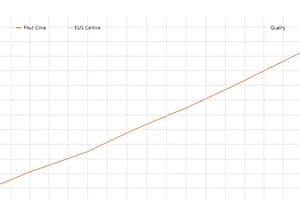Podcast
Questions and Answers
What is the Levey-Jennings Chart used to graph?
What is the Levey-Jennings Chart used to graph?
- Successive QC results (correct)
- Systematic errors
- Test results
- Analytical runs
What does good control results on a Levey-Jennings Chart look like?
What does good control results on a Levey-Jennings Chart look like?
- Evenly distributed QC values about the mean and within +/- 1 SD limits (correct)
- QC values within +2SD limits with no shifts or trends
- QC values returning to within 2SD limit in the next run
- Consecutive QC results within +2SD limits
What constitutes a systematic error shift on a Levey-Jennings Chart?
What constitutes a systematic error shift on a Levey-Jennings Chart?
- 6 consecutive results lying on the same side of the mean within +2SD limits (correct)
- Consecutive QC results within +2SD limits moving in the same direction
- Just 1 QC value outside 2SD but within 3SD limit
- Gradual loss of reliability of the test system
When should an analytical run be rejected based on QC values?
When should an analytical run be rejected based on QC values?
What does a trend on a Levey-Jennings Chart indicate?
What does a trend on a Levey-Jennings Chart indicate?
What is the main cause of a systematic error shift on a Levey-Jennings Chart?
What is the main cause of a systematic error shift on a Levey-Jennings Chart?
How many consecutive results lying on the same side of the mean indicate a systematic error shift on a Levey-Jennings Chart?
How many consecutive results lying on the same side of the mean indicate a systematic error shift on a Levey-Jennings Chart?
In what situation should an analytical run not be rejected based on QC values on a Levey-Jennings Chart?
In what situation should an analytical run not be rejected based on QC values on a Levey-Jennings Chart?
What does a trend on a Levey-Jennings Chart indicate?
What does a trend on a Levey-Jennings Chart indicate?
When are test results still considered in-control on a Levey-Jennings Chart?
When are test results still considered in-control on a Levey-Jennings Chart?
Flashcards
Levey-Jennings Chart graphs what?
Levey-Jennings Chart graphs what?
Successive QC results.
Good control results look like what?
Good control results look like what?
Evenly distributed QC values about the mean and within +/- 1 SD limits.
What is a systematic error shift?
What is a systematic error shift?
Six consecutive results lying on the same side of the mean within +2SD limits.
When reject a run based on QC values?
When reject a run based on QC values?
Signup and view all the flashcards
What does a trend indicate?
What does a trend indicate?
Signup and view all the flashcards
Main cause of systematic error shift?
Main cause of systematic error shift?
Signup and view all the flashcards
How many results show a systematic error?
How many results show a systematic error?
Signup and view all the flashcards
When are test results in-control?
When are test results in-control?
Signup and view all the flashcards
Study Notes
Levey-Jennings Chart
- Used to graph quality control (QC) data over time, allowing for the detection of trends and shifts in analytical performance.
Good Control Results
- Randomly scattered around the mean, with an equal number of points above and below the mean.
- No systematic pattern or trends, indicating analytical performance is within acceptable limits.
Systematic Error Shift
- A consistent deviation from the mean, indicating a problem with the analytical process.
- Constituted by 7 or more consecutive results lying on the same side of the mean.
- Typically caused by a problem with the instrument, reagents, or analytical technique.
Rejecting an Analytical Run
- An analytical run should be rejected if the QC values exceed the acceptable limits or show a systematic error shift.
- Rejection is necessary to prevent erroneous results from being reported.
Trend Identification
- A trend on a Levey-Jennings Chart indicates a gradual change in analytical performance over time.
- May be due to instrument drift, reagent degradation, or other factors, and requires corrective action.
Analytical Run Acceptance
- An analytical run should not be rejected based on QC values if the results are within acceptable limits and show no systematic error shift.
- Results are still considered in-control if the QC values are within the acceptable range and show no trends or shifts.
Studying That Suits You
Use AI to generate personalized quizzes and flashcards to suit your learning preferences.




